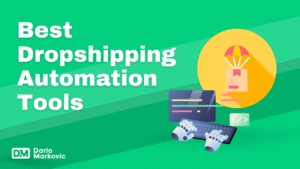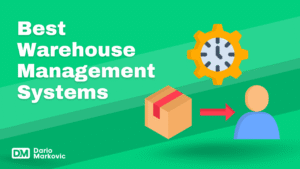Hey there, let’s talk about something that’s been on my mind lately: Salesforce B2B Commerce. I know, it might sound like just another boring business tool. But trust me, this thing is a game-changer.
I’ve seen firsthand how Salesforce B2B Commerce can completely transform how you sell to your customers.
Picture this: a partner in crime that not only ramps up your sales but also smooths out every kink in the process and ensures your customers are left absolutely wowed.
So, if you’re ready to take your B2B business to the next level, keep reading. You’ll be all smiles, no regrets here!
Understanding Salesforce B2B Commerce

If you’ve been in the B2B ecommerce game for a while, you know that it’s a whole different ballgame than traditional B2C ecommerce. The stakes are higher, the orders are bigger, and the relationships are more complex.
That’s where Salesforce B2B Commerce comes in – it’s not just another ecommerce platform; it’s a game-changer.
Key features and benefits
What makes Salesforce B2B Commerce stand out? It’s built on the world’s #1 CRM platform. That means you get all the power of Salesforce’s customer data and insights right at your fingertips.
Plus, with features like custom catalogs, fast reorders, and contract pricing, it’s tailored specifically for the unique needs of B2B buyers.
And let’s not forget about the seamless integrations with tools like Sales Cloud and Service Cloud – talk about a 360-degree view of your customers.
How it differs from traditional ecommerce
B2B ecommerce isn’t just about having a fancy commerce platform. It’s about creating a seamless, personalized experience for your customers.
With Salesforce B2B Commerce, you can do just that. Say goodbye to clunky, one-size-fits-all storefronts and hello to customized catalogs and personalized recommendations based on past orders and customer data.
Importance of a seamless customer experience
At the end of the day, it all comes down to the customer experience. And let me tell you, after implementing Salesforce B2B Commerce for my own business, the difference was night and day.
Our customers could easily find what they needed, place orders faster, and even manage their own accounts.
Plus, with automated order management and real-time inventory management, we could streamline our operations and focus on what really matters – growing our business.
So, if you’re looking for a complete guide to B2B ecommerce success, look no further than Salesforce B2B Commerce. Trust me, your customers (and your bottom line) will thank you.
Optimizing the B2B Buying Experience with Salesforce Commerce Cloud
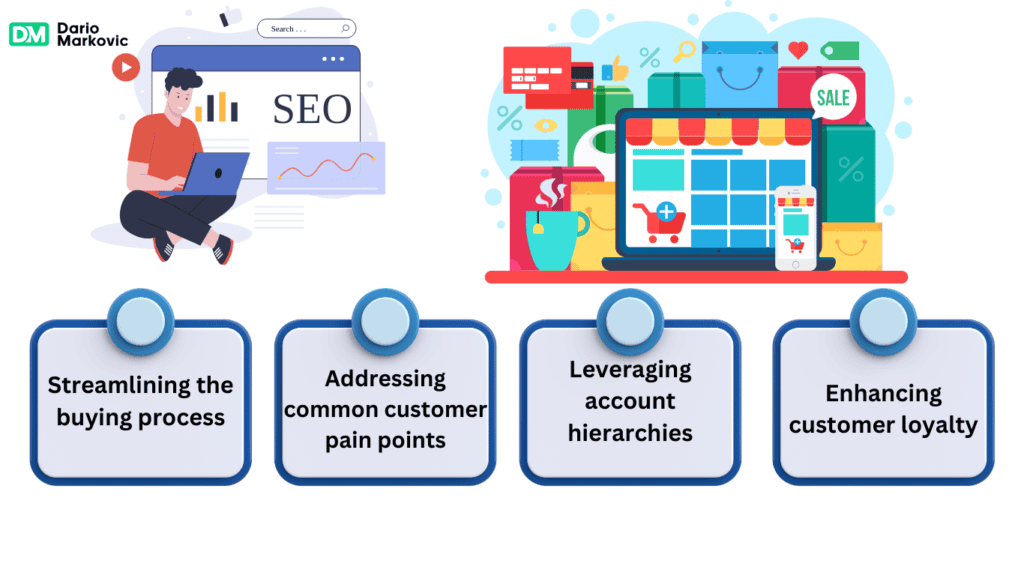 Let’s face it – the B2B buying process can be a real pain. Between long sales cycles, complex approval processes, and multiple stakeholders, it’s enough to make even the most seasoned buyer want to throw in the towel.
Let’s face it – the B2B buying process can be a real pain. Between long sales cycles, complex approval processes, and multiple stakeholders, it’s enough to make even the most seasoned buyer want to throw in the towel. But what if I told you there was a way to make everything a little bit easier? Enter Salesforce Commerce Cloud.
Streamlining the buying process
With Commerce Cloud, you can streamline the entire buying process from start to finish. From custom catalogs and personalized recommendations to self-service account management and easy reordering, it’s all about making life easier for your customers.
And let’s not forget about the power of automation. With tools like Sales Cloud and Service Cloud, you can automate key tasks like quote generation and contract management and even improve customer service inquiries.
That means less time spent on manual tasks and more time focused on closing deals and growing your business.
Addressing common customer pain points
But it’s not just about making things easier for you – it’s about addressing your customers’ daily pain points.
Whether you’re having difficulty finding the right products, there is a lack of transparency around pricing and inventory, or you just want more personalization, Commerce Cloud has you covered.
With features like custom catalogs, real-time inventory updates, and personalized product recommendations, you can create a truly tailored customer experience that keeps buyers returning for more.
Leveraging account hierarchies
One of the key challenges in B2B ecommerce is managing complex account hierarchies and approval processes. However, with Commerce Cloud, you can easily set up and manage multi-level account structures, complete with custom roles and permissions for each user.
That means you can give your customers the flexibility and control they need to manage their own accounts while still maintaining the necessary oversight and approval workflows on your end.
Enhancing customer loyalty
At the end of the day, it’s all about building long-term relationships with your customers. And with Commerce Cloud, you have all the tools you need to create a truly exceptional customer journey.
From personalized content and product recommendations to seamless omnichannel experiences across web, mobile, and in-person interactions, you can create a cohesive brand experience that keeps customers engaged and loyal.
Plus, with built-in tools for managing customer loyalty programs and gathering customer feedback, you can continually optimize and improve the customer experience over time. So, if you’re ready to take your B2B commerce game to the next level, try Salesforce Commerce Cloud.
Empowering Sales Reps with Salesforce B2B Commerce
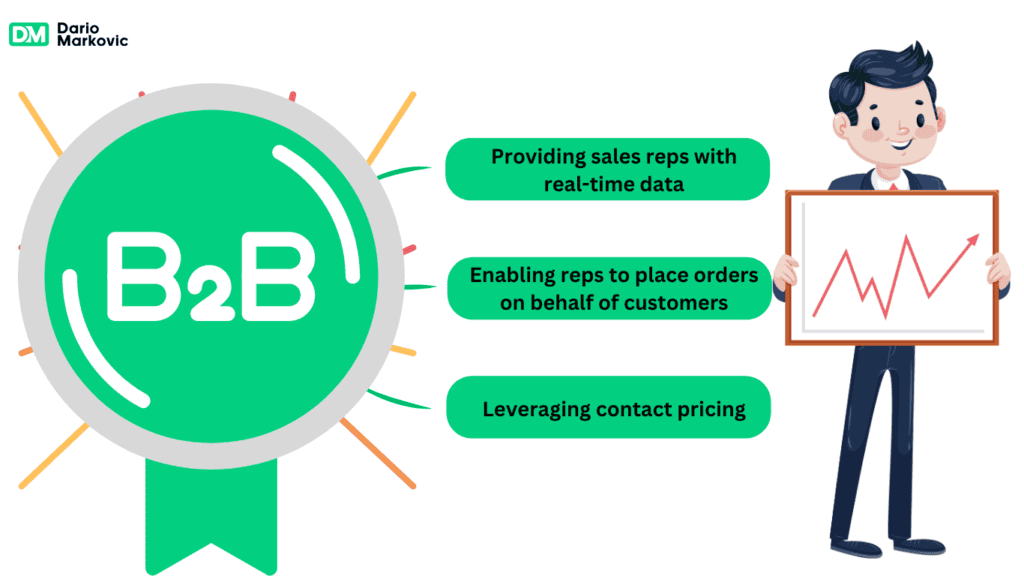 As a sales rep, there’s nothing more frustrating than feeling like you’re flying blind. You’re trying to close deals and hit your targets, but you don’t have the information or tools you need to do your job effectively.
As a sales rep, there’s nothing more frustrating than feeling like you’re flying blind. You’re trying to close deals and hit your targets, but you don’t have the information or tools you need to do your job effectively. That’s where Salesforce B2B Commerce comes in – it’s not just a platform for your customers; it’s a powerful tool for your sales team, too.
Providing sales reps with real-time data
One of the biggest advantages of Salesforce B2B Commerce is the real-time data it provides to sales reps. With access to up-to-the-minute information on customer orders, inventory levels, and more, reps can make informed decisions and provide better service to their accounts.
Plus, with built-in analytics and reporting tools, reps can easily track their performance and identify areas for improvement. That means more closed deals and happier customers.
Enabling reps to place orders on behalf of customers
Another key feature of Salesforce B2B Commerce is the ability for sales reps to place orders on behalf of their customers. This is especially useful for complex or high-volume orders that require a more hands-on approach.
With the ability to access customer account information, view past orders, and apply contract pricing, reps can provide a seamless ordering experience that meets each customer’s unique needs.
Leveraging contract pricing
Contract pricing is another area in which Salesforce B2B Commerce really shines. With the ability to set up custom pricing tiers and discounts based on factors like order volume or customer loyalty, you can create a more personalized and competitive pricing strategy.
With built-in tools for managing contracts and renewals, you can ensure that your customers always get the best possible deal. But it’s not just about the features—it’s about the impact that Salesforce B2B Commerce can have on your customer relationships.
Empowering your sales reps with the tools and information they need to succeed will improve your bottom line and build customer trust and loyalty.
That kind of customer support can take your business to the next level. So, if you’re ready to give your sales team the competitive edge they need, it’s time to take a closer look at Salesforce B2B Commerce.
Personalizing the B2B Commerce Experience
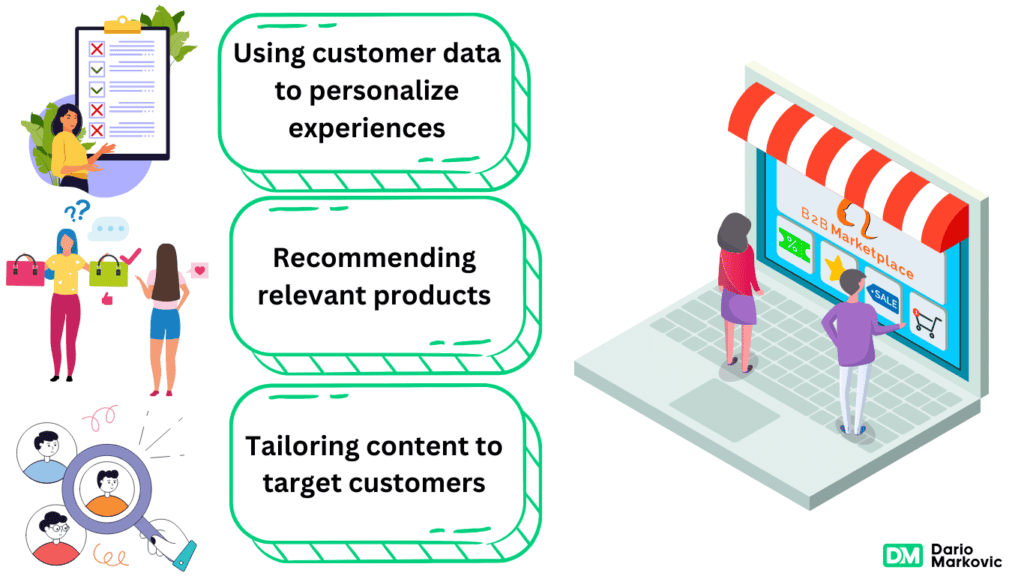 In today’s hyper-competitive B2B landscape, personalization is no longer a nice-to-have—it’s a must-have. With Salesforce B2B Commerce, you have all the tools you need to create personalized experiences that keep your customers returning for more.
In today’s hyper-competitive B2B landscape, personalization is no longer a nice-to-have—it’s a must-have. With Salesforce B2B Commerce, you have all the tools you need to create personalized experiences that keep your customers returning for more.Using customer data to personalize experiences
One key advantage of Salesforce B2B Commerce is the wealth of customer data it provides. From past orders and browsing behavior to account-level preferences and more, you have access to a treasure trove of insights that can help you tailor the customer experience.
With tools like Einstein AI and Commerce Insights, you can analyze and use this data to inform everything from product recommendations and search results to content and promotions.
Recommending relevant products
Product recommendations are another area in which B2B Commerce really shines. By recommending relevant products based on factors like past purchases, browsing behavior, and customer segmentation, you can create a more engaging and personalized shopping experience.
Plus, you can encourage larger orders and drive incremental revenue with tools like product bundles and upsells.
Tailoring content to target customers
But personalization isn’t just about products – it’s about the entire customer journey. With B2B Commerce, you can tailor content and messaging to specific target customers based on industry, company size, and more factors.
From customized landing pages and email campaigns to targeted promotions and discounts, you can create a more relevant and engaging experience at every touchpoint.
The best part? It’s not just about improving the customer experience—it’s about driving real business results.
In fact, studies have shown that personalized customer experiences can lead to a 20% increase in sales and a 15% boost in customer loyalty. So, if you’re ready to take your B2B commerce game to the next level, it’s time to start personalizing.
With Salesforce B2B Commerce, you have all the tools you need to create experiences that are tailored to your unique customers and business needs.
And trust me – once you see the results, you’ll never return to a one-size-fits-all approach again. So what are you waiting for?
Expanding Your Reach with Salesforce B2B Commerce
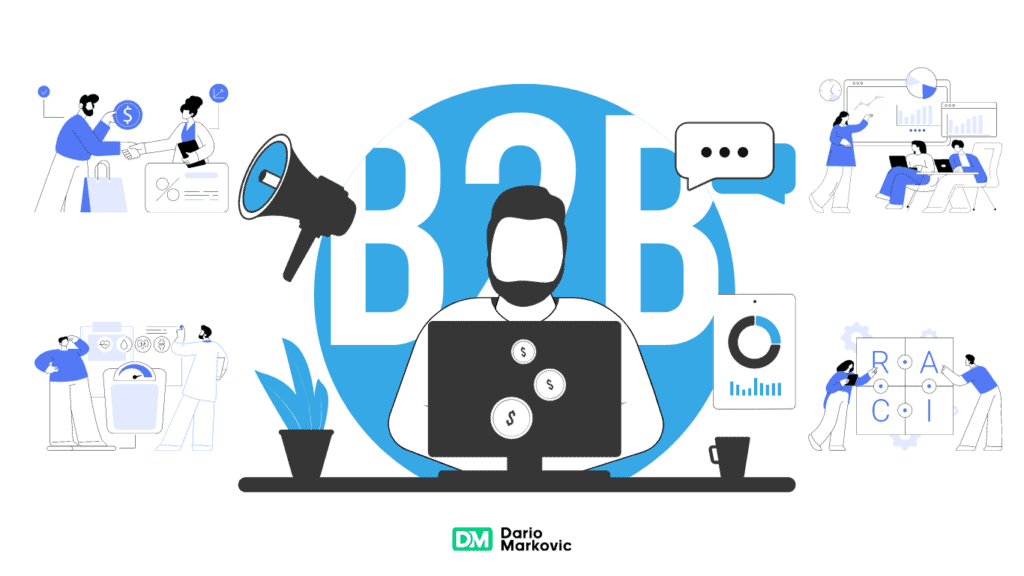 Dreaming of making your mark in more markets? Look no further than Salesforce B2B Commerce; it helps companies shine brighter on numerous platforms, attracting customers like moths to a flame.
Dreaming of making your mark in more markets? Look no further than Salesforce B2B Commerce; it helps companies shine brighter on numerous platforms, attracting customers like moths to a flame.Selling across multiple channels
With Salesforce B2B Commerce, you can create a seamless omnichannel experience for your customers. Whether they prefer to shop through your online store, mobile app, or even social media, Salesforce easily integrates all your sales channels into one unified platform.
So, wherever your customers appear—online or in person—you’ll be ready to give them the same great brand experience while keeping things slick behind the scenes.
Reaching new customers
Salesforce B2B Commerce shines when it comes to discovering new customers and breaking into markets we’ve never touched before. By leveraging the power of digital marketing and SEO, you can increase your online visibility and attract potential customers who may not have otherwise found your business.
Plus, with features like personalized product recommendations and targeted marketing campaigns, you can create a more engaging shopping experience that keeps customers coming back for more.
Expanding into new markets
Whether you’re looking to expand into new geographic regions or target a different industry vertical, Salesforce B2B Commerce can help you achieve your goals.
With built-in tools for managing multiple storefronts, currencies, and languages, you can easily adapt your commerce business to meet the needs of different markets and customer segments.
Dive into rich insights with advanced analytical features – charting performance made easy. Step by step, these metrics empower strategic tweaks, ensuring no opportunity for growth goes unnoticed.
Measuring Success with Salesforce B2B Commerce Analytics
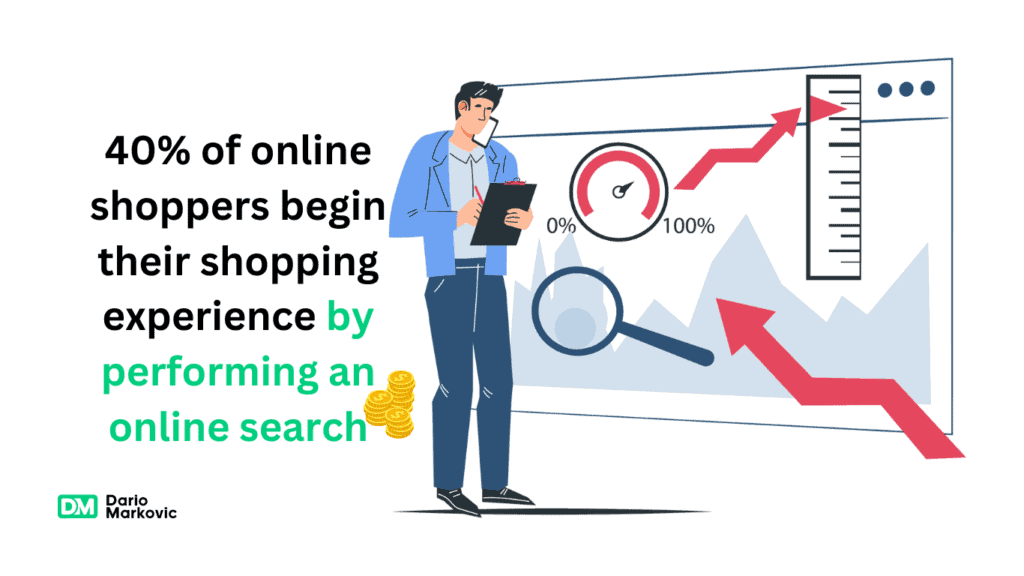 Tracking and measuring your success along the way is essential to truly maximizing the potential of your Salesforce B2B Commerce platform. 40% of online shoppers begin their shopping experience by performing an online search
Tracking and measuring your success along the way is essential to truly maximizing the potential of your Salesforce B2B Commerce platform. 40% of online shoppers begin their shopping experience by performing an online searchTracking key performance indicators
With Salesforce B2B Commerce Analytics, you can easily monitor key performance indicators (KPIs) like sales revenue, conversion rates, average order value, and more.
By setting up customized dashboards and reports, you can get a real-time view of your business’s performance and identify areas for improvement.
This level of visibility is crucial for making informed decisions and optimizing your sales strategies over time.
Analyzing customer behavior
Another powerful feature of Salesforce B2B Commerce Analytics is its ability to provide deep insights into customer behavior and preferences.
By tracking metrics like search queries, product views, and abandoned carts, you can better understand what your customers are looking for and where they may be encountering friction in the buying process.
Armed with this knowledge, you can improve your site navigation, product descriptions, and checkout flow to create a more seamless shopping experience.
Optimizing marketing and sales strategies
Finally, Salesforce B2B Commerce Analytics can help you optimize your marketing and sales strategies for maximum impact.
By peeking behind the curtain of your marketing efforts—those eye-catching ads and catchy emails—you get to figure out what really gets folks talking and buying.
You can also use this data to segment your customer base and create more personalized marketing messages that resonate with each individual buyer.
With the right approach to analytics, you can continuously refine your strategies and stay ahead of the competition in an ever-evolving market.
Ensuring a Smooth Implementation of Salesforce B2B Commerce

Planning for digital transformation
Let’s pause and examine your business practices and the tech you’re currently using before we start setting anything new up.
Identify any gaps or inefficiencies that may need to be addressed as part of your digital transformation journey.
To truly dive into the digital age headfirst, you might need to switch around your workflows, bring in fresh systems, or reconsider how your organization is set up for success.
Integrating with existing systems
One key benefit of Salesforce B2B Commerce is its ability to seamlessly integrate with other business systems, such as ERP, CRM, and marketing automation platforms.
By leveraging pre-built connectors and APIs, you can create a unified view of your customer data and streamline your operations across the entire commerce lifecycle.
However, it’s important to carefully plan and test these integrations to ensure they are properly configured and don’t introduce any new issues or complexities.
Providing mobile-friendly experiences
In today’s mobile-first world, providing a seamless and intuitive experience for customers accessing your site from their smartphones and tablets is essential.
Salesforce B2B Commerce offers responsive design templates, and mobile-optimized checkout flows out of the box, making it easy to create a mobile-friendly storefront.
However, it’s still important to thoroughly test your site across different devices and screen sizes to ensure a consistent and user-friendly experience for all customers.
Choosing the right ecommerce platform
Of course, none of these benefits would be possible without choosing the right ecommerce platform in the first place. When evaluating different options, it’s important to consider factors like scalability, flexibility, and ease of use.
Salesforce B2B Commerce stands out in all these areas, with a robust feature set and a proven track record of helping businesses drive growth and efficiency.
Plus, with a wide range of resources and support options, you can feel confident in successfully implementing and optimizing the platform for your unique needs.
Driving Growth with Salesforce B2B Commerce Best Practices
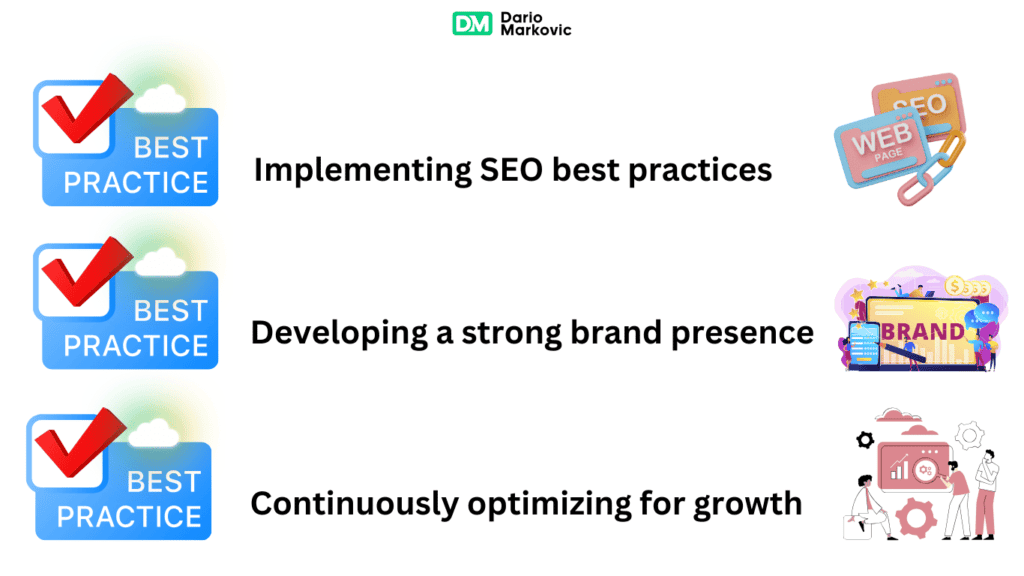 Implementing Salesforce B2B Commerce is just the first step in driving long-term growth and success for your business. Following best practices and optimizing your approach over time is important to maximize the platform’s potential.
Implementing Salesforce B2B Commerce is just the first step in driving long-term growth and success for your business. Following best practices and optimizing your approach over time is important to maximize the platform’s potential.Implementing SEO best practices
One key area to focus on is search engine optimization (SEO). By implementing SEO best practices like keyword research, on-page optimization, and link building, you can improve your site’s visibility in search engine results pages and attract more qualified traffic.
For B2B companies, remember that buyers often start their hunt with a quick Google search.
Climbing to the top of search rankings for the right keywords and crafting content that resonates with your audience’s struggles can make your brand a go-to expert, drawing in more leads who are actually interested.
Developing a strong brand presence
Another critical factor in driving growth with Salesforce B2B Commerce is developing a strong and consistent brand presence across all touchpoints.
This includes everything from your website design and product descriptions to your email marketing and social media campaigns.
Creating a cohesive brand experience that resonates with your target audience can build trust and loyalty over time.
This is particularly important in B2B, where buyers often have longer sales cycles and require more nurturing before purchasing.
Continuously optimizing for growth
Finally, it’s important to remember that driving growth with Salesforce B2B Commerce is an ongoing process, not a one-time event.
To stay ahead of the competition and adapt to changing market conditions, you must continuously monitor your performance metrics, gather customer feedback, and make data-driven optimizations to your site and marketing strategies.
This may involve A/B testing different design elements, experimenting with new promotional tactics, or even expanding into new product categories or geographies.
By staying agile and proactive in your approach, you can ensure that your business is always well-positioned for growth and success in the dynamic world of B2B ecommerce.
Conclusion
We’ve covered a lot of ground today, haven’t we? From understanding the key features of Salesforce B2B Commerce to learning how to personalize the buying experience and drive growth, you’re now equipped with the knowledge you need to take your business to new heights.
But here’s the thing: knowledge is power only if you implement it. So, don’t just let this information sit in your brain. Start implementing these strategies and best practices today. Trust me, your customers (and your bottom line) will thank you.
With Salesforce B2B Commerce by your side, the possibilities are endless. So, what are you waiting for? Let’s get out there and start revolutionizing the way you sell. The future of your business is in your hands, and I can’t wait to see what you achieve.

